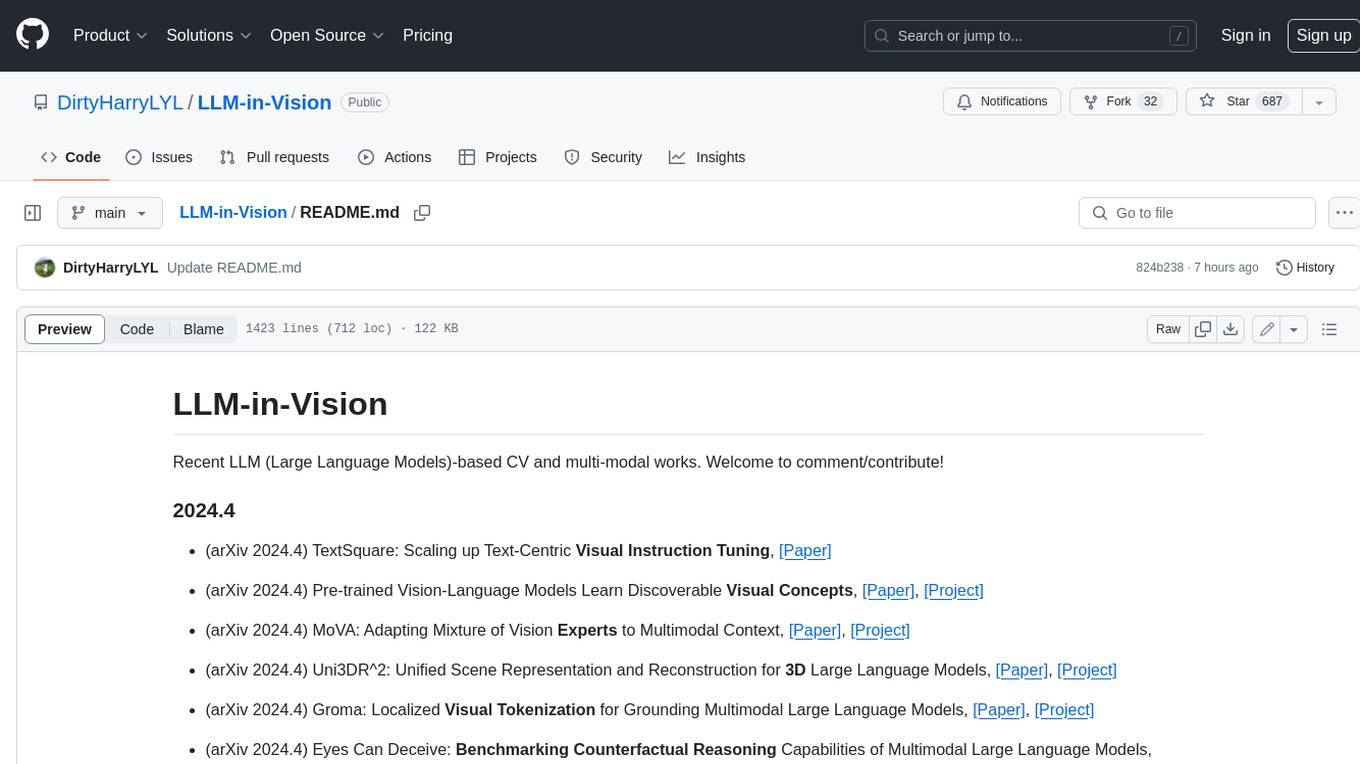
Awesome-LLM-Interpretability
A curated list of LLM Interpretability related material - Tutorial, Library, Survey, Paper, Blog, etc..
Stars: 130
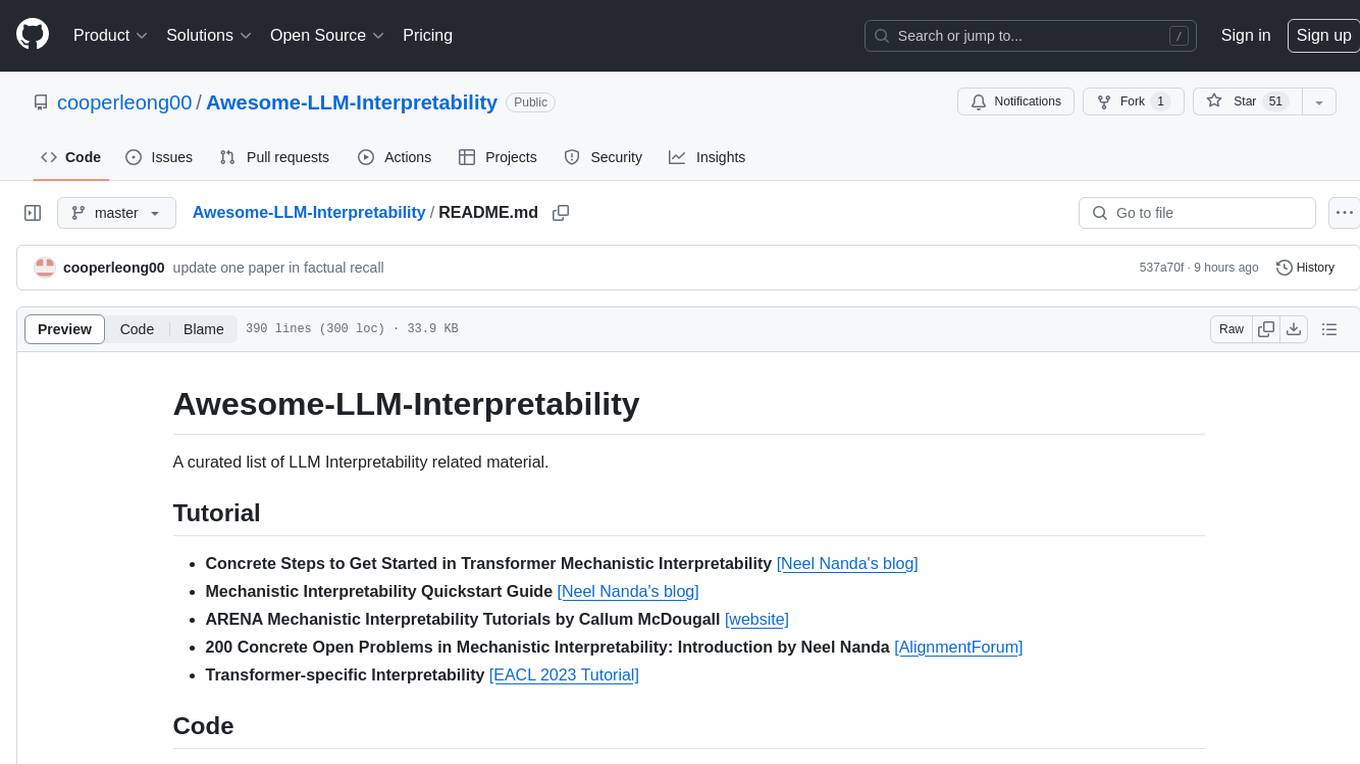
Awesome-LLM-Interpretability is a curated list of materials related to LLM (Large Language Models) interpretability, covering tutorials, code libraries, surveys, videos, papers, and blogs. It includes resources on transformer mechanistic interpretability, visualization, interventions, probing, fine-tuning, feature representation, learning dynamics, knowledge editing, hallucination detection, and redundancy analysis. The repository aims to provide a comprehensive overview of tools, techniques, and methods for understanding and interpreting the inner workings of large language models.
README:
A curated list of LLM Interpretability related material.
- Tutorial
- Code
- Survey
- Video
- Paper & Blog
- Concrete Steps to Get Started in Transformer Mechanistic Interpretability [Neel Nanda's blog]
- Mechanistic Interpretability Quickstart Guide [Neel Nanda's blog]
- ARENA Mechanistic Interpretability Tutorials by Callum McDougall [website]
- 200 Concrete Open Problems in Mechanistic Interpretability: Introduction by Neel Nanda [AlignmentForum]
- Transformer-specific Interpretability [EACL 2023 Tutorial]
-
TransformerLens [github]
- A library for mechanistic interpretability of GPT-style language models
-
CircuitsVis [github]
- Mechanistic Interpretability visualizations
-
baukit [github]
- Contains some methods for tracing and editing internal activations in a network.
-
transformer-debugger [github]
- Transformer Debugger (TDB) is a tool developed by OpenAI's Superalignment team with the goal of supporting investigations into specific behaviors of small language models. The tool combines automated interpretability techniques with sparse autoencoders.
-
pyvene [github]
- Supports customizable interventions on a range of different PyTorch modules
- Supports complex intervention schemes with an intuitive configuration format, and its interventions can be static or include trainable parameters.
-
ViT-Prisma [github]
- An open-source mechanistic interpretability library for vision and multimodal models.
-
pyreft [github]
- A Powerful, Parameter-Efficient, and Interpretable way of fine-tuning
-
SAELens [github]
- Training and analyzing sparse autoencoders on Language Models
- mamba interpretability [github]
- Toward Transparent AI: A Survey on Interpreting the Inner Structures of Deep Neural Networks [SaTML 2023] [arxiv 2207]
- Neuron-level Interpretation of Deep NLP Models: A Survey [TACL 2022]
- Explainability for Large Language Models: A Survey [TIST 2024] [arxiv 2309]
- Opening the Black Box of Large Language Models: Two Views on Holistic Interpretability [arxiv 2402]
- Usable XAI: 10 Strategies Towards Exploiting Explainability in the LLM Era [arxiv 2403]
- Mechanistic Interpretability for AI Safety -- A Review [arxiv 2404]
- A Primer on the Inner Workings of Transformer-based Language Models [arxiv 2405]
- 🌟A Practical Review of Mechanistic Interpretability for Transformer-Based Language Models [arxiv 2407]
- Internal Consistency and Self-Feedback in Large Language Models: A Survey [arxiv 2407]
- The Quest for the Right Mediator: A History, Survey, and Theoretical Grounding of Causal Interpretability [arxiv 2408]
- Attention Heads of Large Language Models: A Survey [arxiv 2409] [github]
Note: These Alignment surveys discuss the relation between Interpretability and LLM Alignment.
-
Large Language Model Alignment: A Survey [arxiv 2309]
-
AI Alignment: A Comprehensive Survey [arxiv 2310] [github] [website]
- Neel Nanda's Channel [Youtube]
- Chris Olah - Looking Inside Neural Networks with Mechanistic Interpretability [Youtube]
- Concrete Open Problems in Mechanistic Interpretability: Neel Nanda at SERI MATS [Youtube]
- BlackboxNLP's Channel [Youtube]
-
🌟ICML 2024 Workshop on Mechanistic Interpretability [openreview]
-
🌟Transformer Circuits Thread [blog]
-
BlackboxNLP: Analyzing and Interpreting Neural Networks for NLP [workshop]
-
AI Alignment Forum [forum]
-
Lesswrong [forum]
-
Neel Nanda [blog] [google scholar]
-
Gor meva [google scholar]
-
David Bau [google scholar]
-
Jacob Steinhardt [google scholar]
-
Yonatan Belinkov [google scholar]
- 🌟A mathematical framework for transformer circuits [blog]
- Patchscopes: A Unifying Framework for Inspecting Hidden Representations of Language Models [arxiv]
-
🌟interpreting GPT: the logit lens [Lesswrong 2020]
-
🌟Analyzing Transformers in Embedding Space [ACL 2023]
-
Eliciting Latent Predictions from Transformers with the Tuned Lens [arxiv 2303]
-
An Adversarial Example for Direct Logit Attribution: Memory Management in gelu-4l arxiv 2310
-
Future Lens: Anticipating Subsequent Tokens from a Single Hidden State [CoNLL 2023]
-
SelfIE: Self-Interpretation of Large Language Model Embeddings [arxiv 2403]
-
InversionView: A General-Purpose Method for Reading Information from Neural Activations [ICML 2024 MI Workshop]
- Enhancing Neural Network Transparency through Representation Analysis [arxiv 2310] [openreview]
- Analyzing And Editing Inner Mechanisms of Backdoored Language Models [arxiv 2303]
- Finding Alignments Between Interpretable Causal Variables and Distributed Neural Representations [arxiv 2303]
- Localizing Model Behavior with Path Patching [arxiv 2304]
- Interpretability at Scale: Identifying Causal Mechanisms in Alpaca [NIPS 2023]
- Towards Best Practices of Activation Patching in Language Models: Metrics and Methods [ICLR 2024]
-
Is This the Subspace You Are Looking for? An Interpretability Illusion for Subspace Activation Patching [ICLR 2024]
- A Reply to Makelov et al. (2023)'s "Interpretability Illusion" Arguments [arxiv 2401]
- CausalGym: Benchmarking causal interpretability methods on linguistic tasks [arxiv 2402]
- 🌟How to use and interpret activation patching [arxiv 2404]
- Towards Automated Circuit Discovery for Mechanistic Interpretability [NIPS 2023]
- Neuron to Graph: Interpreting Language Model Neurons at Scale [arxiv 2305] [openreview]
- Discovering Variable Binding Circuitry with Desiderata [arxiv 2307]
- Discovering Knowledge-Critical Subnetworks in Pretrained Language Models [openreview]
- Attribution Patching Outperforms Automated Circuit Discovery [arxiv 2310]
- AtP*: An efficient and scalable method for localizing LLM behaviour to components [arxiv 2403]
- Have Faith in Faithfulness: Going Beyond Circuit Overlap When Finding Model Mechanisms [arxiv 2403]
- Sparse Feature Circuits: Discovering and Editing Interpretable Causal Graphs in Language Models [arxiv 2403]
- Automatically Identifying Local and Global Circuits with Linear Computation Graphs [arxiv 2405]
- Sparse Autoencoders Enable Scalable and Reliable Circuit Identification in Language Models [arxiv 2405]
- Hypothesis Testing the Circuit Hypothesis in LLMs [ICML 2024 MI Workshop]
- 🌟Towards monosemanticity: Decomposing language models with dictionary learning [Transformer Circuits Thread]
- Sparse Autoencoders Find Highly Interpretable Features in Language Models [ICLR 2024]
- Open Source Sparse Autoencoders for all Residual Stream Layers of GPT2-Small [Alignment Forum]
- Attention SAEs Scale to GPT-2 Small [Alignment Forum]
- We Inspected Every Head In GPT-2 Small using SAEs So You Don’t Have To [Alignment Forum]
- Understanding SAE Features with the Logit Lens [Alignment Forum]
- Scaling Monosemanticity: Extracting Interpretable Features from Claude 3 Sonnet [Transformer Circuits Thread]
- Sparse Autoencoders Enable Scalable and Reliable Circuit Identification in Language Models [arxiv 2405]
- Scaling and evaluating sparse autoencoders [arxiv 2406] [code]
- Measuring Progress in Dictionary Learning for Language Model Interpretability with Board Game Models [ICML 2024 MI Workshop]
- Sparse Autoencoders Match Supervised Features for Model Steering on the IOI Task [ICML 2024 MI Workshop]
- Identifying Functionally Important Features with End-to-End Sparse Dictionary Learning [ICML 2024 MI Workshop]
- Transcoders find interpretable LLM feature circuits [ICML 2024 MI Workshop]
- Jumping Ahead: Improving Reconstruction Fidelity with JumpReLU Sparse Autoencoders [arxiv 2407]
- Sparse Autoencoders Reveal Temporal Difference Learning in Large Language Models [arxiv 2410]
- Mechanistic Permutability: Match Features Across Layers [arxiv 2410]
- Sparse Autoencoders Reveal Universal Feature Spaces Across Large Language Models [arxiv 2410]
- Interpreting Transformer's Attention Dynamic Memory and Visualizing the Semantic Information Flow of GPT [arxiv 2305] [github]
-
Sparse AutoEncoder Visulization [github]
- SAE-VIS: Announcement Post [lesswrong]
- LM Transparency Tool: Interactive Tool for Analyzing Transformer Language Models [arxiv 2404] [[github]](https://github.com/facebookresearch/ llm-transparency-tool)
- Tracr: Compiled Transformers as a Laboratory for Interpretability [arxiv 2301]
- Opening the AI black box: program synthesis via mechanistic interpretability [arxiv 2402]
- An introduction to graphical tensor notation for mechanistic interpretability [arxiv 2402]
- Look Before You Leap: A Universal Emergent Decomposition of Retrieval Tasks in Language Models [arxiv 2312]
- RAVEL: Evaluating Interpretability Methods on Disentangling Language Model Representations [arxiv 2402]
- Towards Principled Evaluations of Sparse Autoencoders for Interpretability and Control [arxiv 2405]
- InterpBench: Semi-Synthetic Transformers for Evaluating Mechanistic Interpretability Techniques [arxiv 2407]
- Circuit Component Reuse Across Tasks in Transformer Language Models [ICLR 2024 spotlight]
- Towards Universality: Studying Mechanistic Similarity Across Language Model Architectures [arxvi 2410]
- From Tokens to Words: On the Inner Lexicon of LLMs [arxiv 2410]
- Towards a Mechanistic Interpretation of Multi-Step Reasoning Capabilities of Language Models [EMNLP 2023]
- How Large Language Models Implement Chain-of-Thought? [openreview]
- Do Large Language Models Latently Perform Multi-Hop Reasoning? [arxiv 2402]
- How to think step-by-step: A mechanistic understanding of chain-of-thought reasoning [arxiv 2402]
- Focus on Your Question! Interpreting and Mitigating Toxic CoT Problems in Commonsense Reasoning [arxiv 2402]
- Iteration Head: A Mechanistic Study of Chain-of-Thought [arxiv 2406]
- From Sparse Dependence to Sparse Attention: Unveiling How Chain-of-Thought Enhances Transformer Sample Efficiency [arxiv 2410]
- 🌟Interpretability in the wild: a circuit for indirect object identification in GPT-2 small [ICLR 2023]
- Entity Tracking in Language Models [ACL 2023]
- How does GPT-2 compute greater-than?: Interpreting mathematical abilities in a pre-trained language model [NIPS 2023]
- Can Transformers Learn to Solve Problems Recursively? [arxiv 2305]
- Analyzing And Editing Inner Mechanisms of Backdoored Language Models [NeurIPS 2023 Workshop]
- Does Circuit Analysis Interpretability Scale? Evidence from Multiple Choice Capabilities in Chinchilla [arxiv 2307]
- Refusal mechanisms: initial experiments with Llama-2-7b-chat [AlignmentForum 2312]
- Forbidden Facts: An Investigation of Competing Objectives in Llama-2 [arxiv 2312]
- How do Language Models Bind Entities in Context? [ICLR 2024]
- How Language Models Learn Context-Free Grammars? [openreview]
- 🌟A Mechanistic Understanding of Alignment Algorithms: A Case Study on DPO and Toxicity [arxiv 2401]
- Do Llamas Work in English? On the Latent Language of Multilingual Transformers [arxiv 2402]
- Evidence of Learned Look-Ahead in a Chess-Playing Neural Network [arxiv2406]
- 🌟Progress measures for grokking via mechanistic interpretability [ICLR 2023]
- 🌟The Clock and the Pizza: Two Stories in Mechanistic Explanation of Neural Networks [NIPS 2023]
- Interpreting the Inner Mechanisms of Large Language Models in Mathematical Addition [openreview]
- Arithmetic with Language Models: from Memorization to Computation [openreview]
- Carrying over Algorithm in Transformers [openreview]
- A simple and interpretable model of grokking modular arithmetic tasks [openreview]
- Understanding Addition in Transformers [ICLR 2024]
- Increasing Trust in Language Models through the Reuse of Verified Circuits [arxiv 2402]
- Pre-trained Large Language Models Use Fourier Features to Compute Addition [arxiv 2406]
- 🌟In-context learning and induction heads [Transformer Circuits Thread]
- In-Context Learning Creates Task Vectors [EMNLP 2023 Findings]
-
Label Words are Anchors: An Information Flow Perspective for Understanding In-Context Learning [EMNLP 2023]
- EMNLP 2023 best paper
- LLMs Represent Contextual Tasks as Compact Function Vectors [ICLR 2024]
- Understanding In-Context Learning in Transformers and LLMs by Learning to Learn Discrete Functions [ICLR 2024]
- Where Does In-context Machine Translation Happen in Large Language Models? [openreview]
- In-Context Learning in Large Language Models: A Neuroscience-inspired Analysis of Representations [openreview]
- Analyzing Task-Encoding Tokens in Large Language Models [arxiv 2401]
- How do Large Language Models Learn In-Context? Query and Key Matrices of In-Context Heads are Two Towers for Metric Learning [arxiv 2402]
- Parallel Structures in Pre-training Data Yield In-Context Learning [arxiv 2402]
- What needs to go right for an induction head? A mechanistic study of in-context learning circuits and their formation [arxiv 2404]
- Task Diversity Shortens the ICL Plateau [arxiv 2410]
- 🌟Dissecting Recall of Factual Associations in Auto-Regressive Language Models [EMNLP 2023]
- Characterizing Mechanisms for Factual Recall in Language Models [EMNLP 2023]
- Summing Up the Facts: Additive Mechanisms behind Factual Recall in LLMs [openreview]
- A Mechanism for Solving Relational Tasks in Transformer Language Models [openreview]
- Overthinking the Truth: Understanding how Language Models Process False Demonstrations [ICLR 2024 spotlight]
- 🌟Fact Finding: Attempting to Reverse-Engineer Factual Recall on the Neuron Level [AlignmentForum 2312]
- Cutting Off the Head Ends the Conflict: A Mechanism for Interpreting and Mitigating Knowledge Conflicts in Language Models [arxiv 2402]
- Competition of Mechanisms: Tracing How Language Models Handle Facts and Counterfactuals [arxiv 2402]
- A Glitch in the Matrix? Locating and Detecting Language Model Grounding with Fakepedia [arxiv 2403]
- Mechanisms of non-factual hallucinations in language models [arxiv 2403]
- Interpreting Key Mechanisms of Factual Recall in Transformer-Based Language Models [arxiv 2403]
- Locating and Editing Factual Associations in Mamba [arxiv 2404]
- Probing Language Models on Their Knowledge Source [[arxiv 2410]](https://arxiv.org/abs/2410.05817}
- Do Llamas Work in English? On the Latent Language of Multilingual Transformers [arxiv 2402]
- Language-Specific Neurons: The Key to Multilingual Capabilities in Large Language Models [arxiv 2402]
- How do Large Language Models Handle Multilingualism? [arxiv 2402]
- Large Language Models are Parallel Multilingual Learners [arxiv 2403]
- Understanding the role of FFNs in driving multilingual behaviour in LLMs [arxiv 2404]
- How do Llamas process multilingual text? A latent exploration through activation patching [ICML 2024 MI Workshop]
- Concept Space Alignment in Multilingual LLMs [EMNLP 2024]
- On the Similarity of Circuits across Languages: a Case Study on the Subject-verb Agreement Task [EMNLP 2024 Findings]
- Interpreting CLIP's Image Representation via Text-Based Decomposition [ICLR 2024 oral]
- Interpreting CLIP with Sparse Linear Concept Embeddings (SpLiCE) [NIPS 2024]
- Diffusion Lens: Interpreting Text Encoders in Text-to-Image Pipelines [arxiv 2403]
- The First to Know: How Token Distributions Reveal Hidden Knowledge in Large Vision-Language Models? [arxiv 2403]
- Understanding Information Storage and Transfer in Multi-modal Large Language Models [arxiv 2406]
- Towards Interpreting Visual Information Processing in Vision-Language Models [arxiv 2410]
- The Hydra Effect: Emergent Self-repair in Language Model Computations [arxiv 2307]
- Unveiling A Core Linguistic Region in Large Language Models [arxiv 2310]
- Exploring the Residual Stream of Transformers [arxiv 2312]
- Characterizing Large Language Model Geometry Solves Toxicity Detection and Generation [arxiv 2312]
- Explorations of Self-Repair in Language Models [arxiv 2402]
- Massive Activations in Large Language Models [arxiv 2402]
- Interpreting Context Look-ups in Transformers: Investigating Attention-MLP Interactions [arxiv 2402]
- Fantastic Semantics and Where to Find Them: Investigating Which Layers of Generative LLMs Reflect Lexical Semantics [arxiv 2403]
- The Heuristic Core: Understanding Subnetwork Generalization in Pretrained Language Models [arxiv 2403]
- Localizing Paragraph Memorization in Language Models [github 2403]
-
🌟Awesome-Attention-Heads [github]
- A carefully compiled list that summarizes the diverse functions of the attention heads.
-
🌟In-context learning and induction heads [Transformer Circuits Thread]
-
On the Expressivity Role of LayerNorm in Transformers' Attention [ACL 2023 Findings]
-
On the Role of Attention in Prompt-tuning [ICML 2023]
-
Copy Suppression: Comprehensively Understanding an Attention Head [ICLR 2024]
-
Successor Heads: Recurring, Interpretable Attention Heads In The Wild [ICLR 2024]
-
A phase transition between positional and semantic learning in a solvable model of dot-product attention [arxiv 2024]
-
Retrieval Head Mechanistically Explains Long-Context Factuality [arxiv 2404]
-
Iteration Head: A Mechanistic Study of Chain-of-Thought [arxiv]
- 🌟Transformer Feed-Forward Layers Are Key-Value Memories [EMNLP 2021]
- Transformer Feed-Forward Layers Build Predictions by Promoting Concepts in the Vocabulary Space [EMNLP 2022]
- What does GPT store in its MLP weights? A case study of long-range dependencies [openreview]
- Understanding the role of FFNs in driving multilingual behaviour in LLMs [arxiv 2404]
- 🌟Toy Models of Superposition [Transformer Circuits Thread]
- Knowledge Neurons in Pretrained Transformers [ACL 2022]
- Polysemanticity and Capacity in Neural Networks [arxiv 2210]
- 🌟Finding Neurons in a Haystack: Case Studies with Sparse Probing [TMLR 2023]
- DEPN: Detecting and Editing Privacy Neurons in Pretrained Language Models [EMNLP 2023]
- Neurons in Large Language Models: Dead, N-gram, Positional [arxiv 2309]
- Universal Neurons in GPT2 Language Models [arxiv 2401]
- Language-Specific Neurons: The Key to Multilingual Capabilities in Large Language Models [arxiv 2402]
- How do Large Language Models Handle Multilingualism? [arxiv 2402]
- PURE: Turning Polysemantic Neurons Into Pure Features by Identifying Relevant Circuits [arxiv 2404]
- JoMA: Demystifying Multilayer Transformers via JOint Dynamics of MLP and Attention [ICLR 2024]
- Learning Associative Memories with Gradient Descent [arxiv 2402]
- Mechanics of Next Token Prediction with Self-Attention [arxiv 2402]
- The Garden of Forking Paths: Observing Dynamic Parameters Distribution in Large Language Models [arxiv 2403]
- LLM Circuit Analyses Are Consistent Across Training and Scale [ICML 2024 MI Workshop]
- Geometric Signatures of Compositionality Across a Language Model's Lifetime [arxiv 2410]
- 🌟Progress measures for grokking via mechanistic interpretability [ICLR 2023]
- A Toy Model of Universality: Reverse Engineering How Networks Learn Group Operations [ICML 2023]
- 🌟The Mechanistic Basis of Data Dependence and Abrupt Learning in an In-Context Classification Task [ICLR 2024 oral]
- Highest scores at ICLR 2024: 10, 10, 8, 8. And by one author only!
- Sudden Drops in the Loss: Syntax Acquisition, Phase Transitions, and Simplicity Bias in MLMs [ICLR 2024 spotlight]
- A simple and interpretable model of grokking modular arithmetic tasks [openreview]
- Unified View of Grokking, Double Descent and Emergent Abilities: A Perspective from Circuits Competition [arxiv 2402]
- Interpreting Grokked Transformers in Complex Modular Arithmetic [arxiv 2402]
- Towards Tracing Trustworthiness Dynamics: Revisiting Pre-training Period of Large Language Models [arxiv 2402]
- Learning to grok: Emergence of in-context learning and skill composition in modular arithmetic tasks [arxiv 2406]
- Grokked Transformers are Implicit Reasoners: A Mechanistic Journey to the Edge of Generalization [ICML 2024 MI Workshop]
- Studying Large Language Model Generalization with Influence Functions [arxiv 2308]
- Mechanistically analyzing the effects of fine-tuning on procedurally defined tasks [ICLR 2024]
- Fine-Tuning Enhances Existing Mechanisms: A Case Study on Entity Tracking [ICLR 2024]
- The Hidden Space of Transformer Language Adapters [arxiv 2402]
- Dissecting Fine-Tuning Unlearning in Large Language Models [EMNLP 2024]
- Implicit Representations of Meaning in Neural Language Models [ACL 2021]
- All Roads Lead to Rome? Exploring the Invariance of Transformers' Representations [arxiv 2305]
- Observable Propagation: Uncovering Feature Vectors in Transformers [openreview]
- In-Context Learning in Large Language Models: A Neuroscience-inspired Analysis of Representations [openreview]
- Challenges with unsupervised LLM knowledge discovery [arxiv 2312]
- Still No Lie Detector for Language Models: Probing Empirical and Conceptual Roadblocks [arxiv 2307]
- Position Paper: Toward New Frameworks for Studying Model Representations [arxiv 2402]
- How Large Language Models Encode Context Knowledge? A Layer-Wise Probing Study [arxiv 2402]
- More than Correlation: Do Large Language Models Learn Causal Representations of Space [arxiv 2312]
- Do Large Language Models Mirror Cognitive Language Processing? [arxiv 2402]
- On the Scaling Laws of Geographical Representation in Language Models [arxiv 2402]
- Monotonic Representation of Numeric Properties in Language Models [arxiv 2403]
- Exploring Concept Depth: How Large Language Models Acquire Knowledge at Different Layers? [arxiv 2404]
- Simple probes can catch sleeper agents [Anthropic Blog]
- PaCE: Parsimonious Concept Engineering for Large Language Models [arxiv 2406]
- The Geometry of Categorical and Hierarchical Concepts in Large Language Models [ICML 2024 MI Workshop]
- Concept Space Alignment in Multilingual LLMs [EMNLP 2024]
- Sparse Autoencoders Reveal Universal Feature Spaces Across Large Language Models [arxiv 2410]
- 🌟Actually, Othello-GPT Has A Linear Emergent World Representation [Neel Nanda's blog]
- Language Models Linearly Represent Sentiment [openreview]
- Language Models Represent Space and Time [openreview]
- The Geometry of Truth: Emergent Linear Structure in Large Language Model Representations of True/False Datasets [openreview]
- Linearity of Relation Decoding in Transformer Language Models [ICLR 2024]
- The Linear Representation Hypothesis and the Geometry of Large Language Models [arxiv 2311]
- Language Models Represent Beliefs of Self and Others [arxiv 2402]
- On the Origins of Linear Representations in Large Language Models [arxiv 2403]
- Refusal in LLMs is mediated by a single direction [Lesswrong 2024]
- ReFT: Representation Finetuning for Language Models [arxiv 2404] [github]
- 🌟Inference-Time Intervention: Eliciting Truthful Answers from a Language Model [NIPS 2023] [github]
- Activation Addition: Steering Language Models Without Optimization [arxiv 2308]
- Self-Detoxifying Language Models via Toxification Reversal [EMNLP 2023]
- DoLa: Decoding by Contrasting Layers Improves Factuality in Large Language Models [arxiv 2309]
- In-context Vectors: Making In Context Learning More Effective and Controllable Through Latent Space Steering [arxiv 211]
- Steering Llama 2 via Contrastive Activation Addition [arxiv 2312]
- A Language Model's Guide Through Latent Space [arxiv 2402]
- Backdoor Activation Attack: Attack Large Language Models using Activation Steering for Safety-Alignment [arxiv 2311]
- Extending Activation Steering to Broad Skills and Multiple Behaviours [arxiv 2403]
- Spectral Editing of Activations for Large Language Model Alignment [arxiv 2405]
- Controlling Large Language Model Agents with Entropic Activation Steering [arxiv 2406]
- Analyzing the Generalization and Reliability of Steering Vectors [ICML 2024 MI Workshop]
- Towards Inference-time Category-wise Safety Steering for Large Language Models [arxiv 2410]
- A Timeline and Analysis for Representation Plasticity in Large Language Models [arxiv 2410]
- Locating and Editing Factual Associations in GPT (ROME) [NIPS 2022] [github]
- Memory-Based Model Editing at Scale [ICML 2022]
- Editing models with task arithmetic [ICLR 2023]
- Mass-Editing Memory in a Transformer [ICLR 2023]
- Detecting Edit Failures In Large Language Models: An Improved Specificity Benchmark [ACL 2023 Findings]
- Can LMs Learn New Entities from Descriptions? Challenges in Propagating Injected Knowledge [ACL 2023]
- Does Localization Inform Editing? Surprising Differences in Causality-Based Localization vs. Knowledge Editing in Language Models [NIPS 2023]
- Inspecting and Editing Knowledge Representations in Language Models [arxiv 2304] [github]
- Methods for Measuring, Updating, and Visualizing Factual Beliefs in Language Models [EACL 2023]
- Editing Common Sense in Transformers [EMNLP 2023]
- DEPN: Detecting and Editing Privacy Neurons in Pretrained Language Models [EMNLP 2023]
- MQuAKE: Assessing Knowledge Editing in Language Models via Multi-Hop Questions [EMNLP 2023]
- PMET: Precise Model Editing in a Transformer [arxiv 2308]
- Untying the Reversal Curse via Bidirectional Language Model Editing [arxiv 2310]
- Unveiling the Pitfalls of Knowledge Editing for Large Language Models [ICLR 2024]
- A Comprehensive Study of Knowledge Editing for Large Language Models [arxiv 2401]
- Trace and Edit Relation Associations in GPT [arxiv 2401]
- Model Editing with Canonical Examples [arxiv 2402]
- Updating Language Models with Unstructured Facts: Towards Practical Knowledge Editing [arxiv 2402]
- Editing Conceptual Knowledge for Large Language Models [arxiv 2403]
- Editing the Mind of Giants: An In-Depth Exploration of Pitfalls of Knowledge Editing in Large Language Models [arxiv 2406]
- Locate-then-edit for Multi-hop Factual Recall under Knowledge Editing [arxiv 2410]
- The Internal State of an LLM Knows When It's Lying [EMNLP 2023 Findings]
- Do Androids Know They're Only Dreaming of Electric Sheep? [arxiv 2312]
- INSIDE: LLMs' Internal States Retain the Power of Hallucination Detection [ICLR 2024]
- TruthX: Alleviating Hallucinations by Editing Large Language Models in Truthful Space [arxiv 2402]
- Characterizing Truthfulness in Large Language Model Generations with Local Intrinsic Dimension [arxiv 2402]
- Whispers that Shake Foundations: Analyzing and Mitigating False Premise Hallucinations in Large Language Models [arxiv 2402]
- In-Context Sharpness as Alerts: An Inner Representation Perspective for Hallucination Mitigation [arxiv 2403]
- Unsupervised Real-Time Hallucination Detection based on the Internal States of Large Language Models [arxiv 2403]
- Adaptive Activation Steering: A Tuning-Free LLM Truthfulness Improvement Method for Diverse Hallucinations Categories [arxiv 2406]
- Not all Layers of LLMs are Necessary during Inference [arxiv 2403]
- ShortGPT: Layers in Large Language Models are More Redundant Than You Expect [arxiv 2403]
- The Unreasonable Ineffectiveness of the Deeper Layers [arxiv 2403]
- The Remarkable Robustness of LLMs: Stages of Inference? [ICML 2024 MI Workshop]
For Tasks:
Click tags to check more tools for each tasksFor Jobs:
Alternative AI tools for Awesome-LLM-Interpretability
Similar Open Source Tools

Awesome-LLM-Interpretability
Awesome-LLM-Interpretability is a curated list of materials related to LLM (Large Language Models) interpretability, covering tutorials, code libraries, surveys, videos, papers, and blogs. It includes resources on transformer mechanistic interpretability, visualization, interventions, probing, fine-tuning, feature representation, learning dynamics, knowledge editing, hallucination detection, and redundancy analysis. The repository aims to provide a comprehensive overview of tools, techniques, and methods for understanding and interpreting the inner workings of large language models.
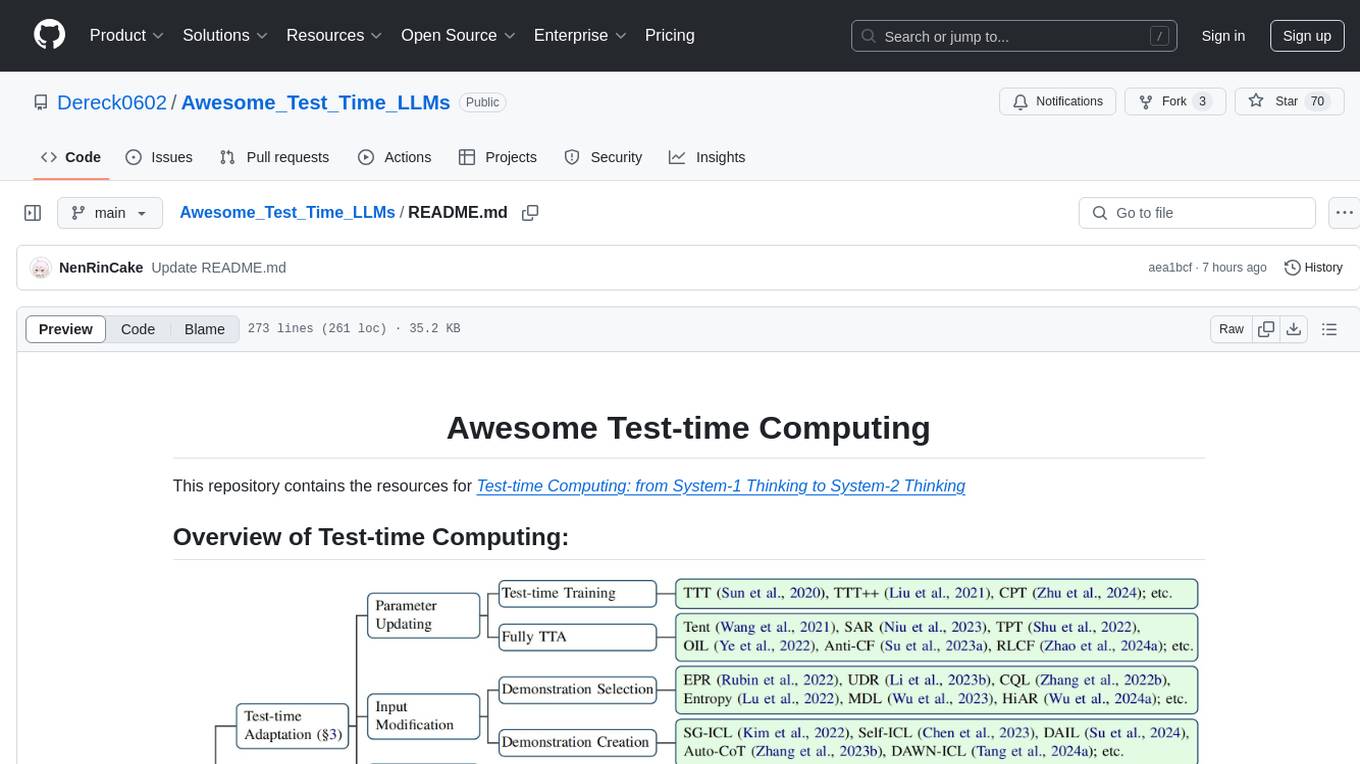
Awesome_Test_Time_LLMs
This repository focuses on test-time computing, exploring various strategies such as test-time adaptation, modifying the input, editing the representation, calibrating the output, test-time reasoning, and search strategies. It covers topics like self-supervised test-time training, in-context learning, activation steering, nearest neighbor models, reward modeling, and multimodal reasoning. The repository provides resources including papers and code for researchers and practitioners interested in enhancing the reasoning capabilities of large language models.
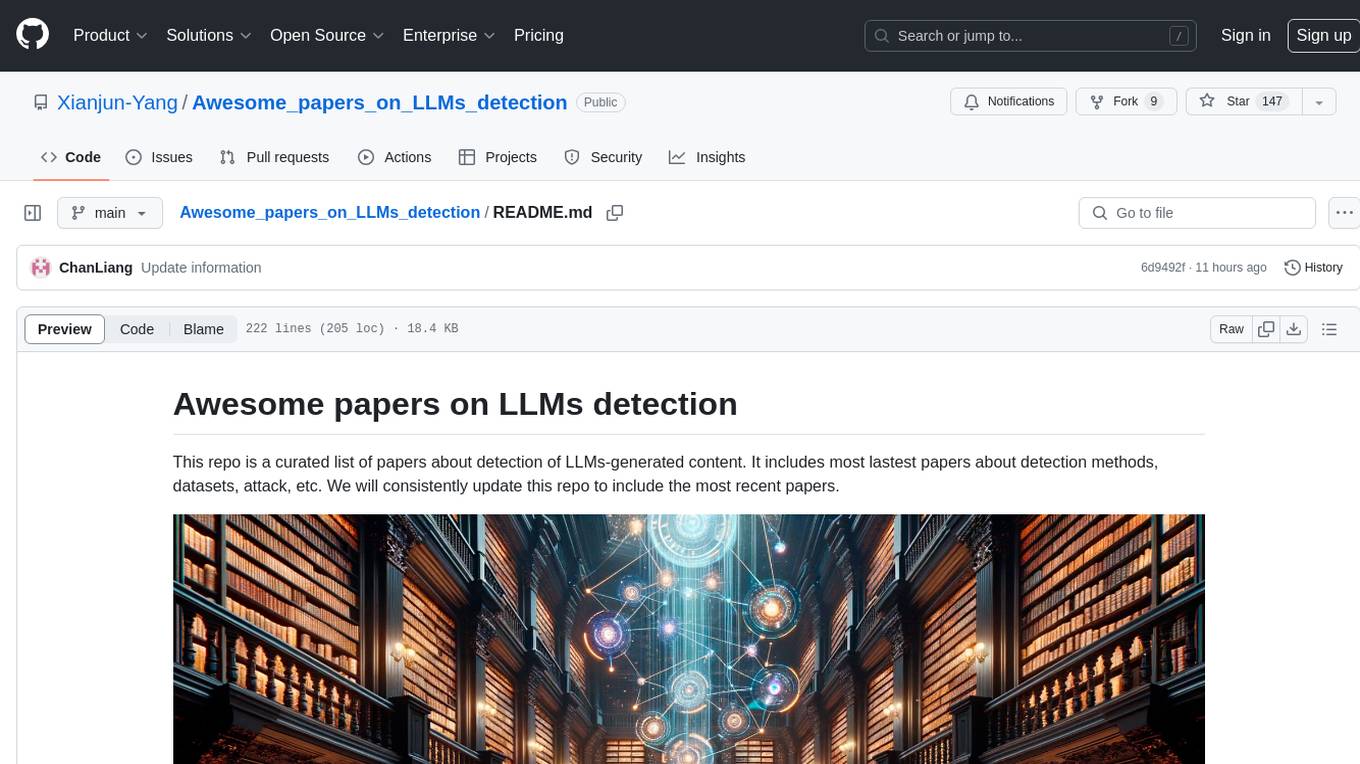
Awesome_papers_on_LLMs_detection
This repository is a curated list of papers focused on the detection of Large Language Models (LLMs)-generated content. It includes the latest research papers covering detection methods, datasets, attacks, and more. The repository is regularly updated to include the most recent papers in the field.

awesome-and-novel-works-in-slam
This repository contains a curated list of cutting-edge works in Simultaneous Localization and Mapping (SLAM). It includes research papers, projects, and tools related to various aspects of SLAM, such as 3D reconstruction, semantic mapping, novel algorithms, large-scale mapping, and more. The repository aims to showcase the latest advancements in SLAM technology and provide resources for researchers and practitioners in the field.
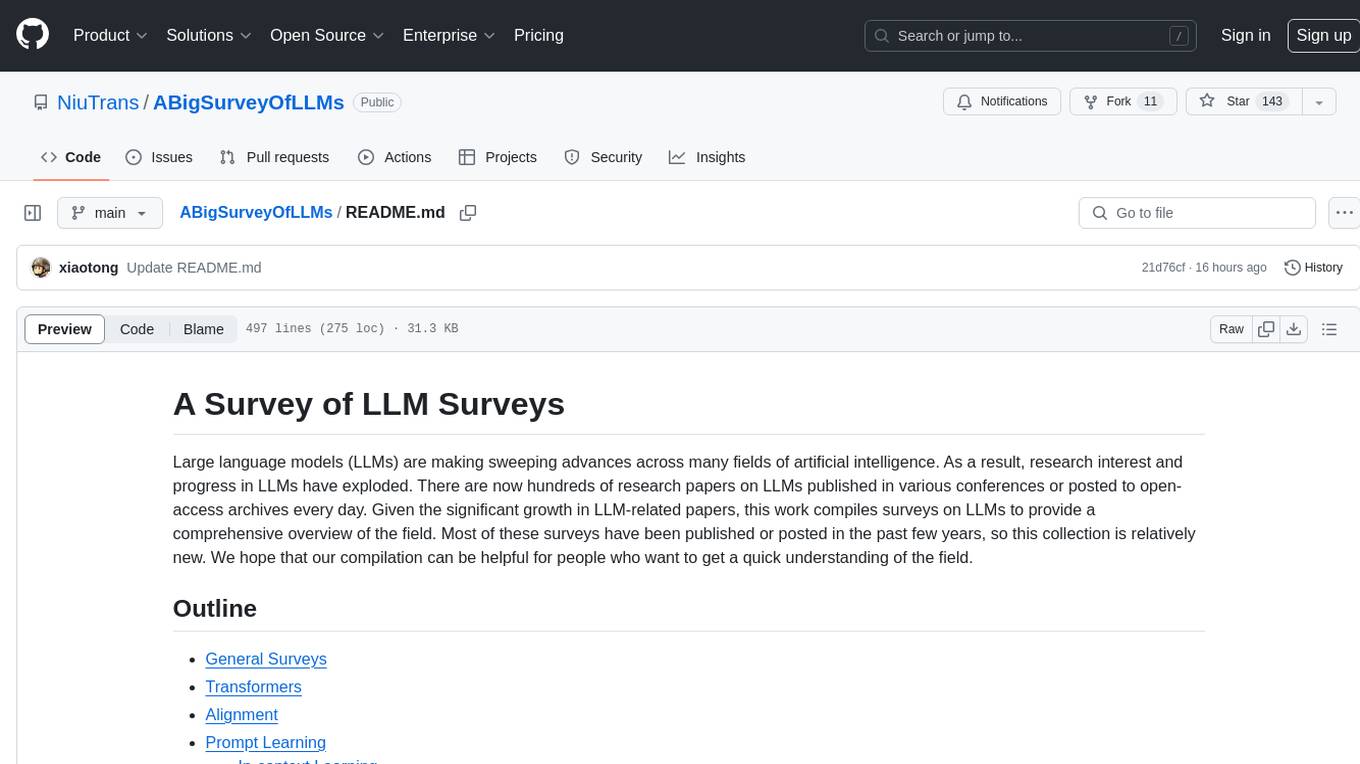
ABigSurveyOfLLMs
ABigSurveyOfLLMs is a repository that compiles surveys on Large Language Models (LLMs) to provide a comprehensive overview of the field. It includes surveys on various aspects of LLMs such as transformers, alignment, prompt learning, data management, evaluation, societal issues, safety, misinformation, attributes of LLMs, efficient LLMs, learning methods for LLMs, multimodal LLMs, knowledge-based LLMs, extension of LLMs, LLMs applications, and more. The repository aims to help individuals quickly understand the advancements and challenges in the field of LLMs through a collection of recent surveys and research papers.
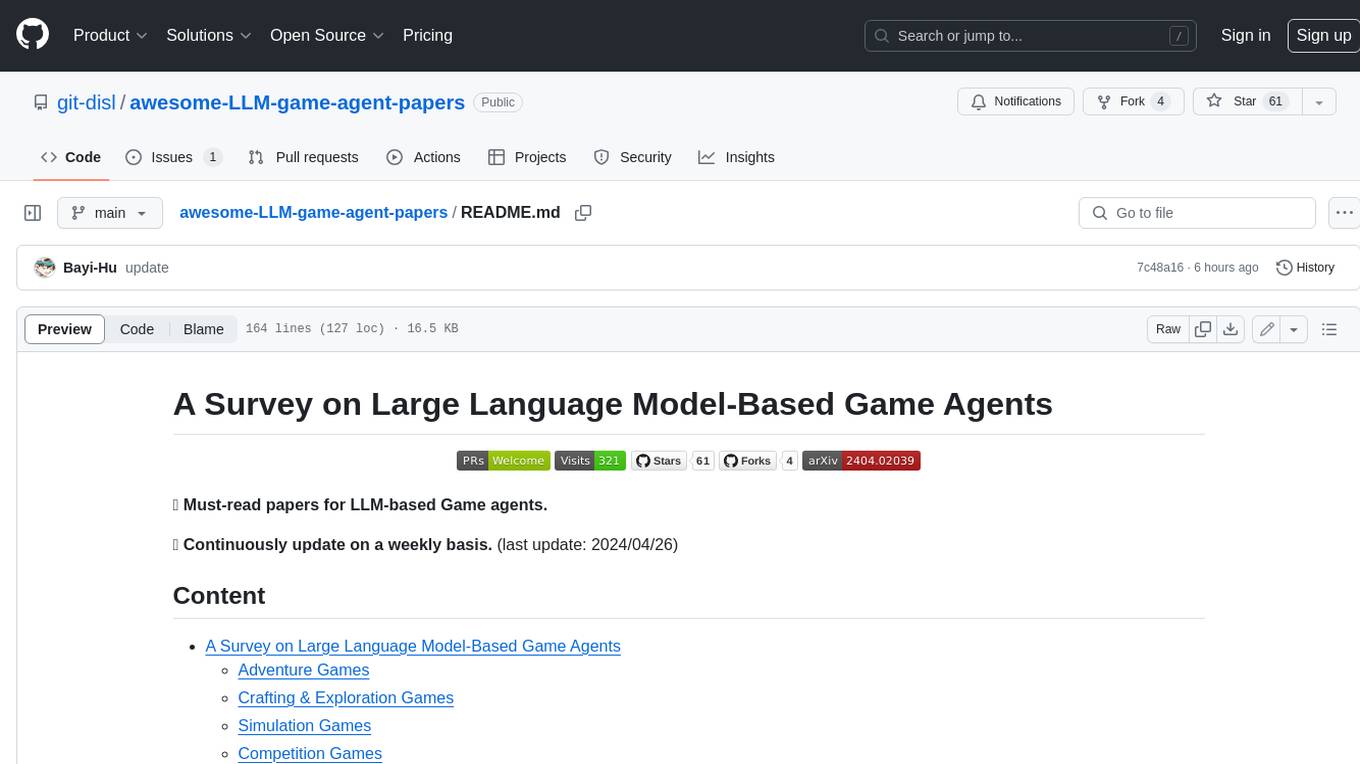
awesome-LLM-game-agent-papers
This repository provides a comprehensive survey of research papers on large language model (LLM)-based game agents. LLMs are powerful AI models that can understand and generate human language, and they have shown great promise for developing intelligent game agents. This survey covers a wide range of topics, including adventure games, crafting and exploration games, simulation games, competition games, cooperation games, communication games, and action games. For each topic, the survey provides an overview of the state-of-the-art research, as well as a discussion of the challenges and opportunities for future work.
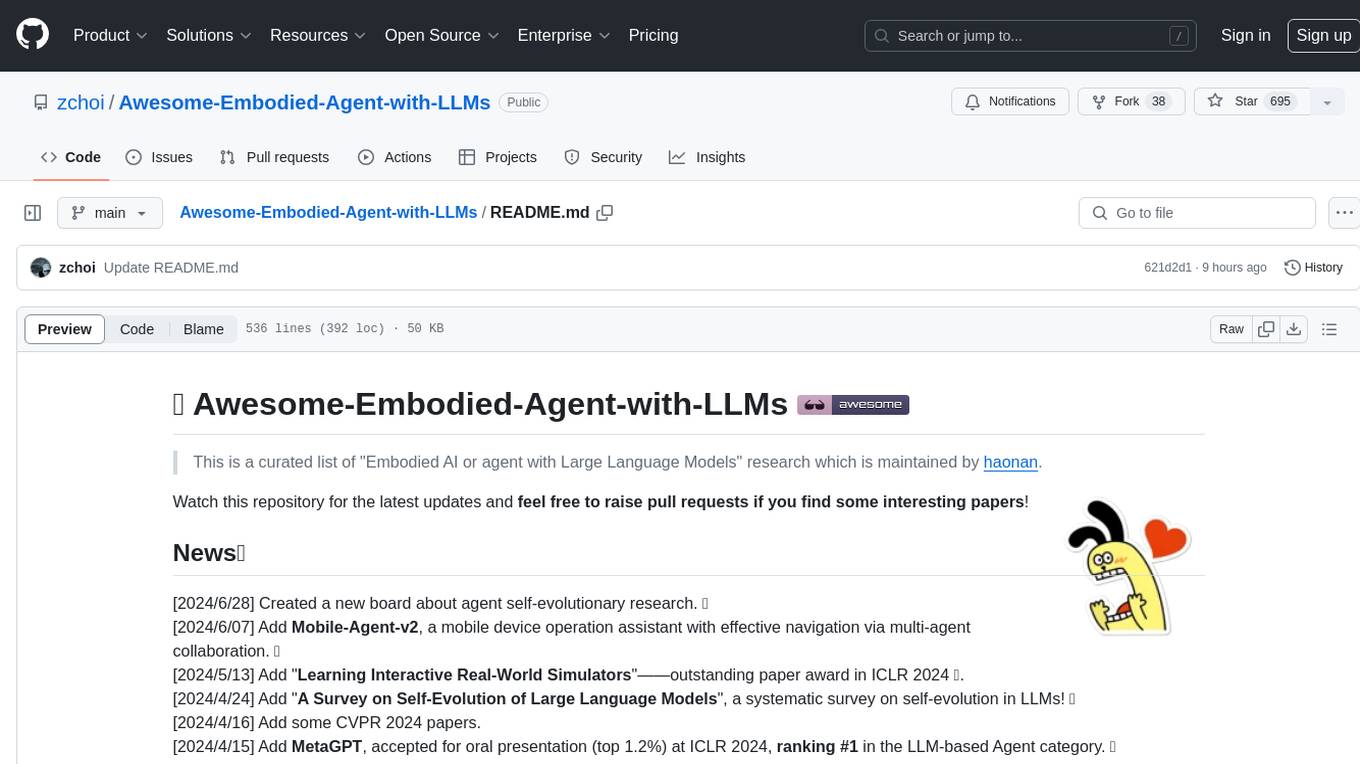
Awesome-Embodied-Agent-with-LLMs
This repository, named Awesome-Embodied-Agent-with-LLMs, is a curated list of research related to Embodied AI or agents with Large Language Models. It includes various papers, surveys, and projects focusing on topics such as self-evolving agents, advanced agent applications, LLMs with RL or world models, planning and manipulation, multi-agent learning and coordination, vision and language navigation, detection, 3D grounding, interactive embodied learning, rearrangement, benchmarks, simulators, and more. The repository provides a comprehensive collection of resources for individuals interested in exploring the intersection of embodied agents and large language models.
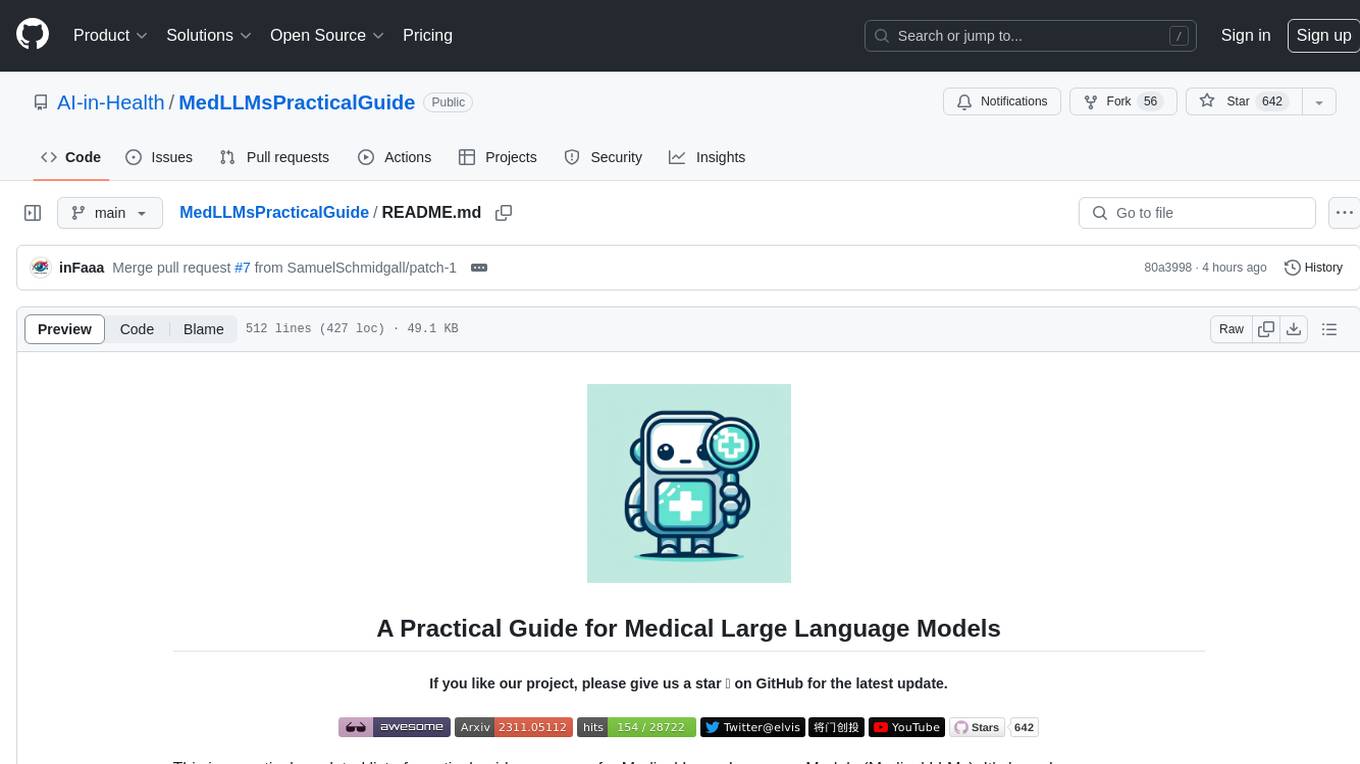
MedLLMsPracticalGuide
This repository serves as a practical guide for Medical Large Language Models (Medical LLMs) and provides resources, surveys, and tools for building, fine-tuning, and utilizing LLMs in the medical domain. It covers a wide range of topics including pre-training, fine-tuning, downstream biomedical tasks, clinical applications, challenges, future directions, and more. The repository aims to provide insights into the opportunities and challenges of LLMs in medicine and serve as a practical resource for constructing effective medical LLMs.
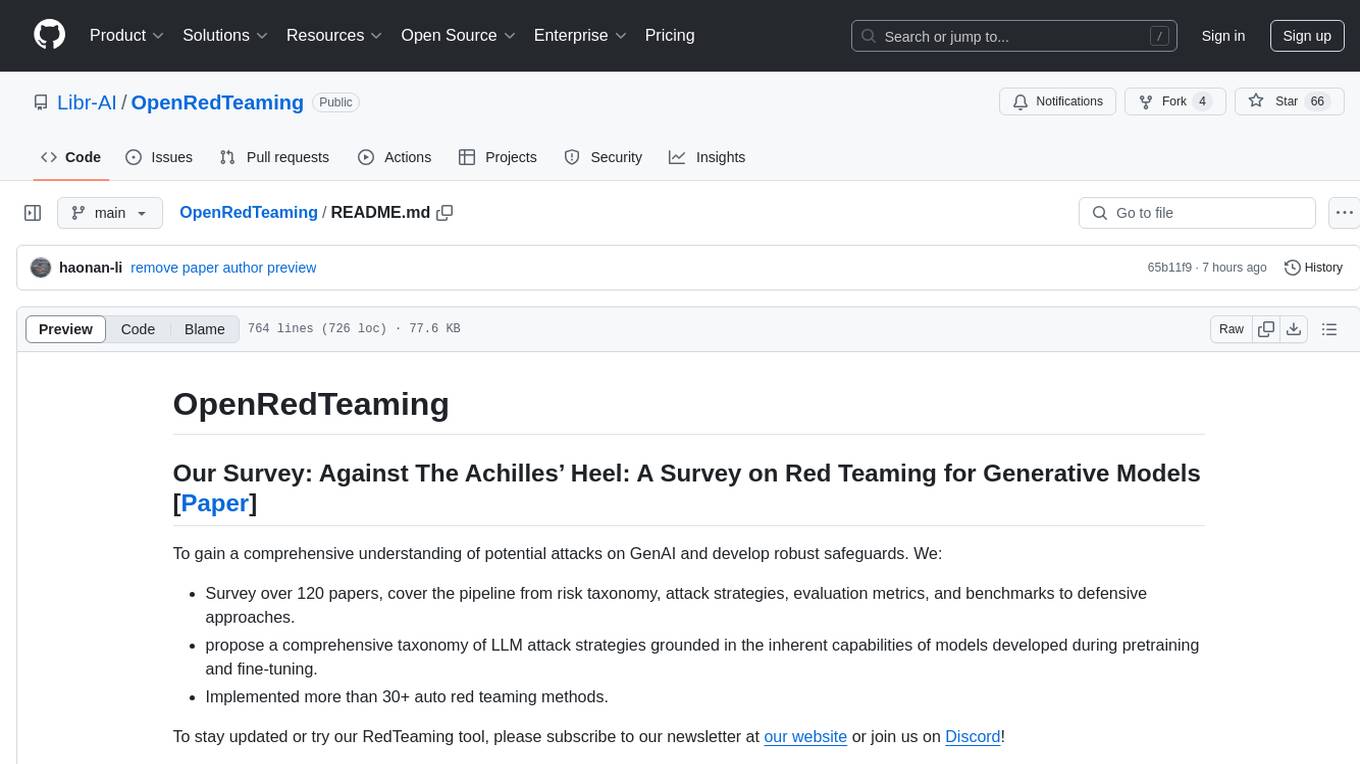
OpenRedTeaming
OpenRedTeaming is a repository focused on red teaming for generative models, specifically large language models (LLMs). The repository provides a comprehensive survey on potential attacks on GenAI and robust safeguards. It covers attack strategies, evaluation metrics, benchmarks, and defensive approaches. The repository also implements over 30 auto red teaming methods. It includes surveys, taxonomies, attack strategies, and risks related to LLMs. The goal is to understand vulnerabilities and develop defenses against adversarial attacks on large language models.
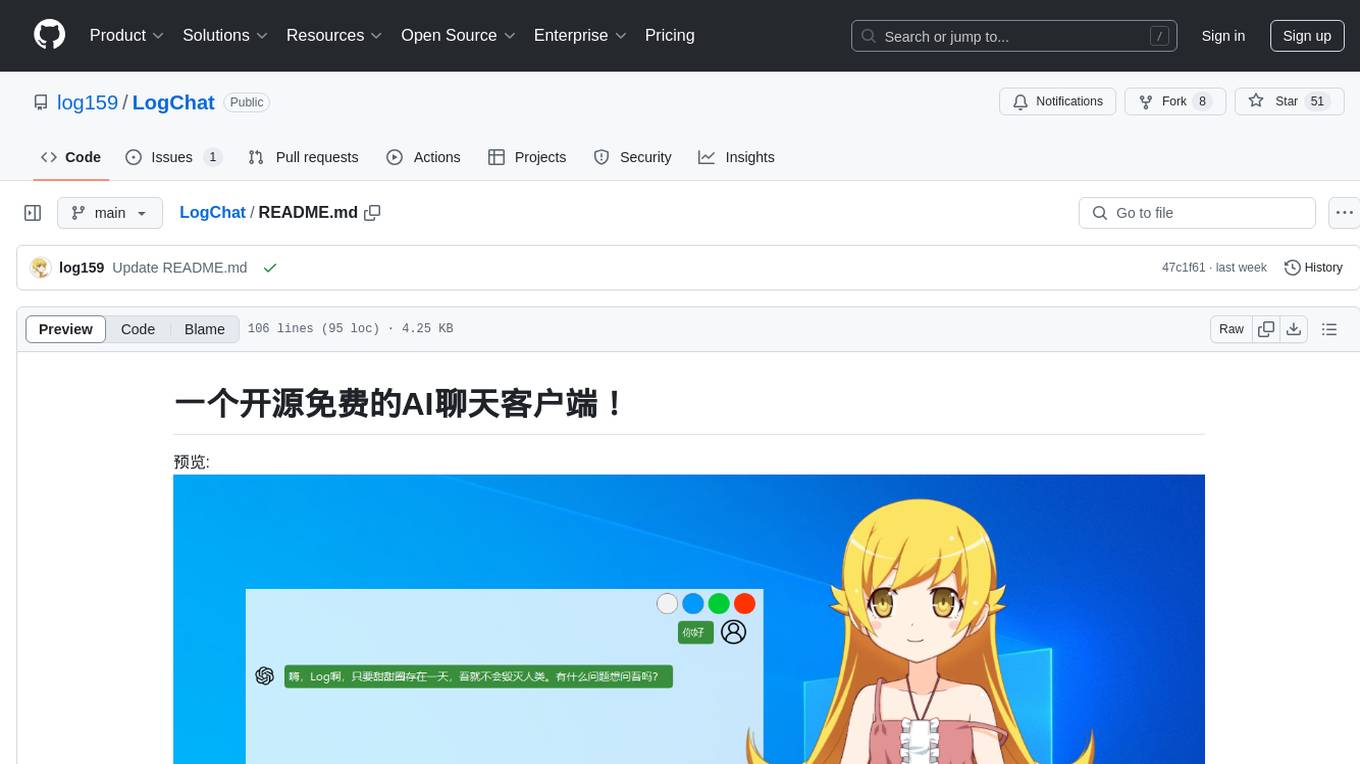
LogChat
LogChat is an open-source and free AI chat client that supports various chat models and technologies such as ChatGPT, 讯飞星火, DeepSeek, LLM, TTS, STT, and Live2D. The tool provides a user-friendly interface designed using Qt Creator and can be used on Windows systems without any additional environment requirements. Users can interact with different AI models, perform voice synthesis and recognition, and customize Live2D character models. LogChat also offers features like language translation, AI platform integration, and menu items like screenshot editing, clock, and application launcher.
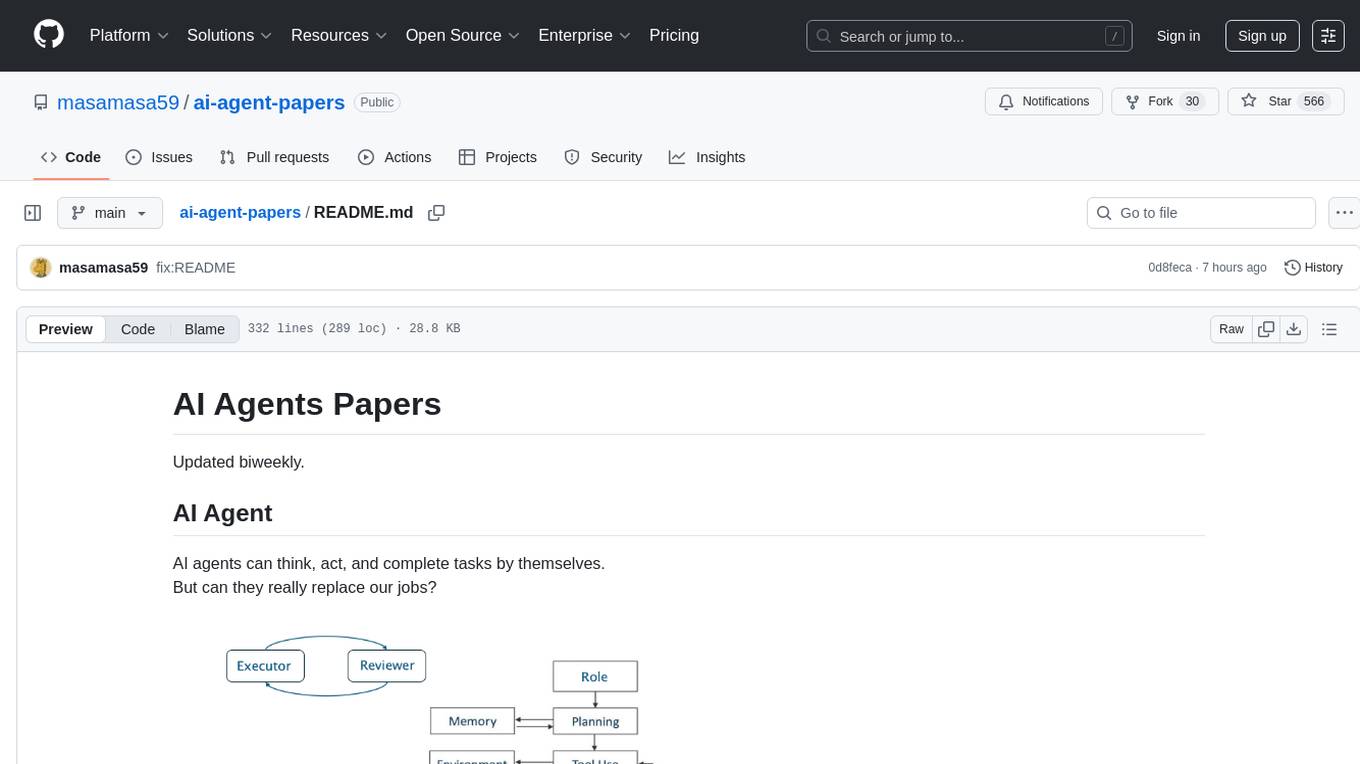
ai-agent-papers
The AI Agents Papers repository provides a curated collection of papers focusing on AI agents, covering topics such as agent capabilities, applications, architectures, and presentations. It includes a variety of papers on ideation, decision making, long-horizon tasks, learning, memory-based agents, self-evolving agents, and more. The repository serves as a valuable resource for researchers and practitioners interested in AI agent technologies and advancements.
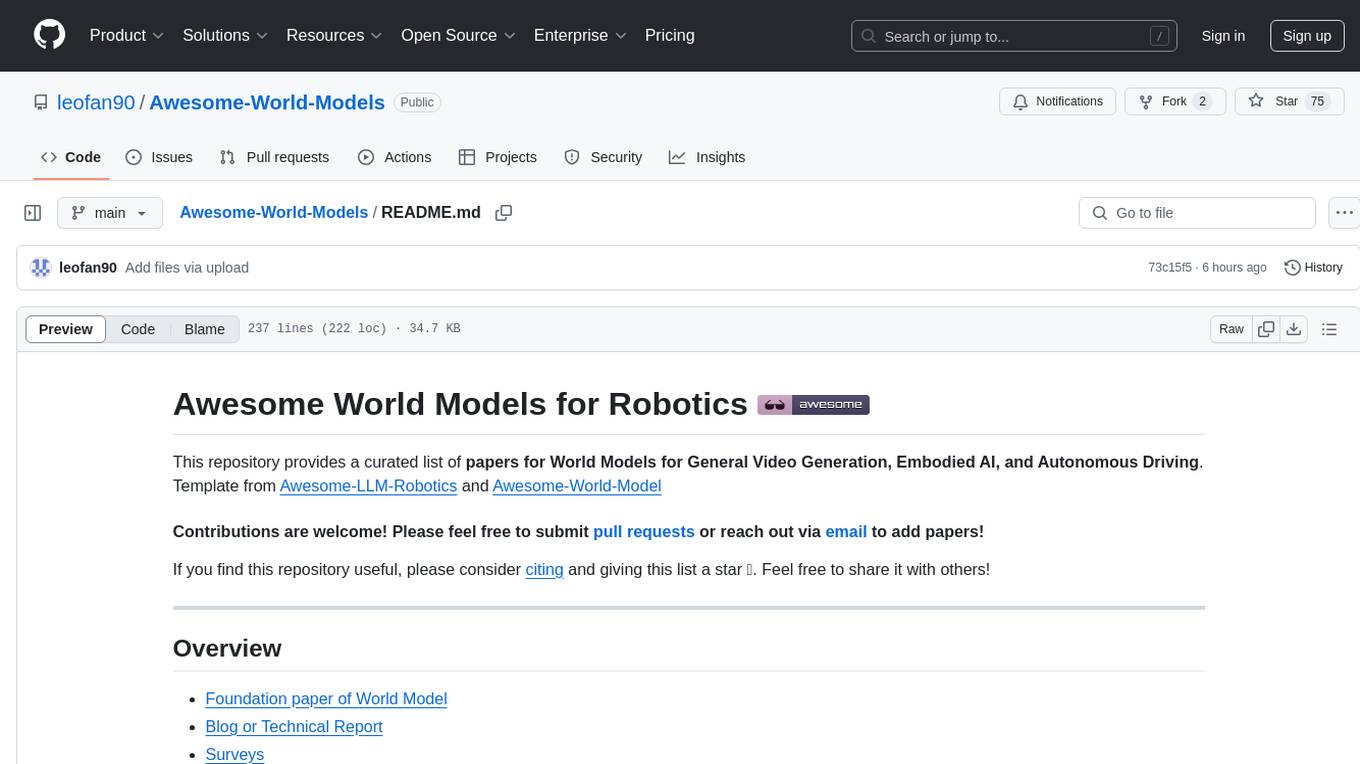
Awesome-World-Models
This repository is a curated list of papers related to World Models for General Video Generation, Embodied AI, and Autonomous Driving. It includes foundation papers, blog posts, technical reports, surveys, benchmarks, and specific world models for different applications. The repository serves as a valuable resource for researchers and practitioners interested in world models and their applications in robotics and AI.
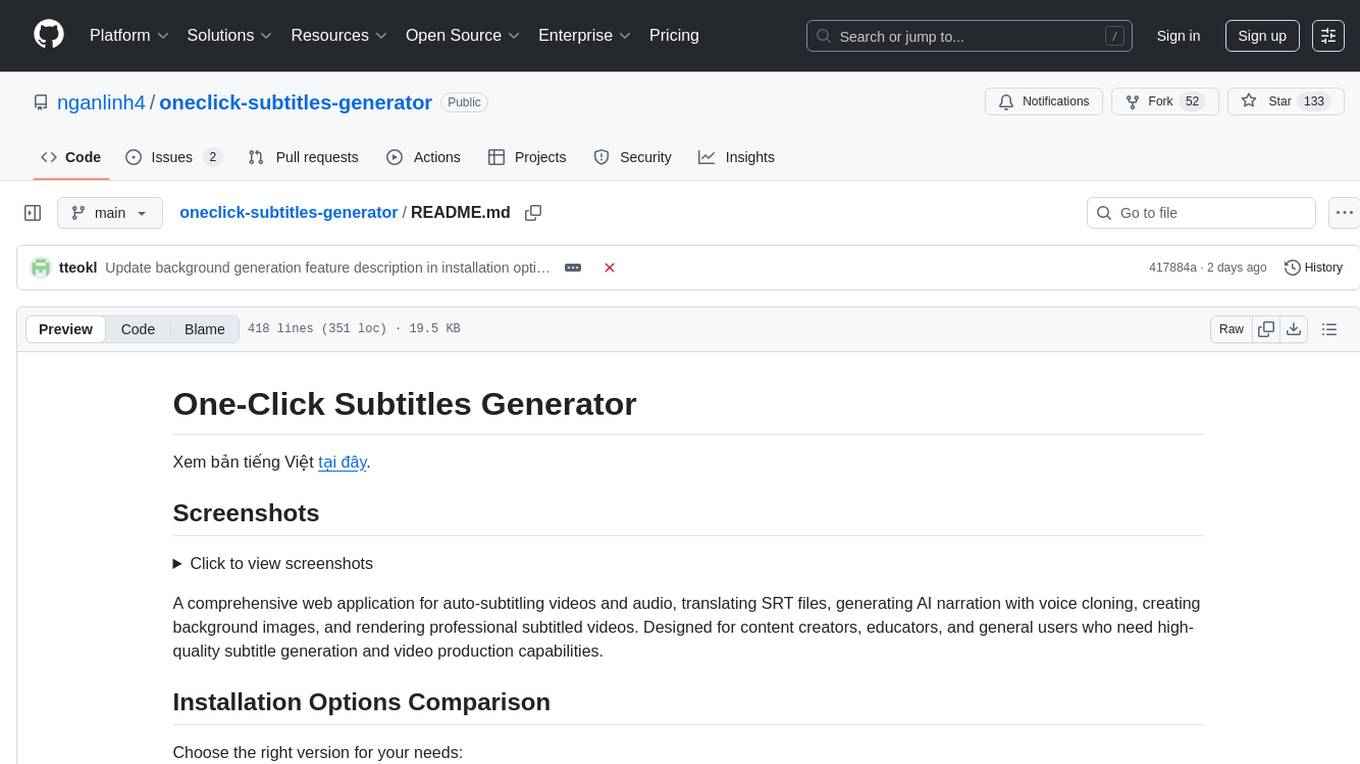
oneclick-subtitles-generator
A comprehensive web application for auto-subtitling videos and audio, translating SRT files, generating AI narration with voice cloning, creating background images, and rendering professional subtitled videos. Designed for content creators, educators, and general users who need high-quality subtitle generation and video production capabilities.
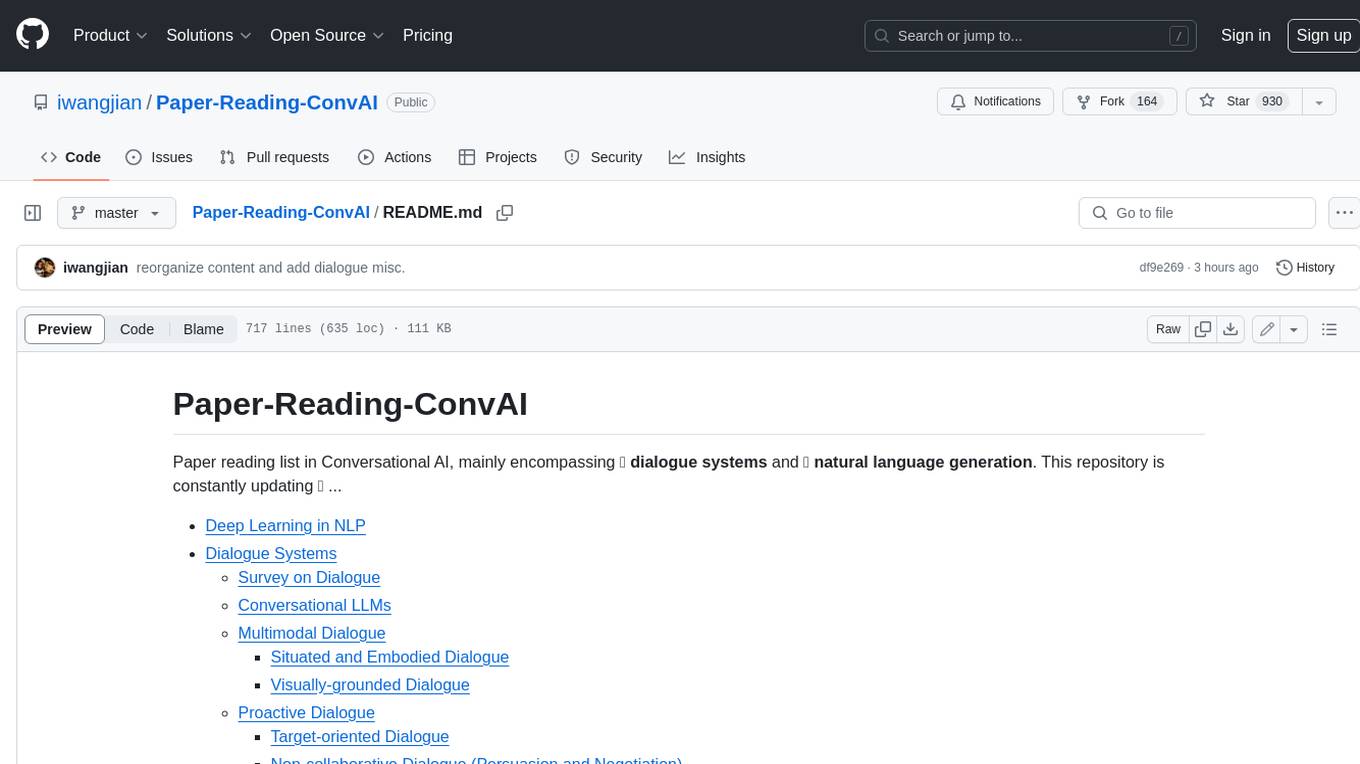
Paper-Reading-ConvAI
Paper-Reading-ConvAI is a repository that contains a list of papers, datasets, and resources related to Conversational AI, mainly encompassing dialogue systems and natural language generation. This repository is constantly updating.
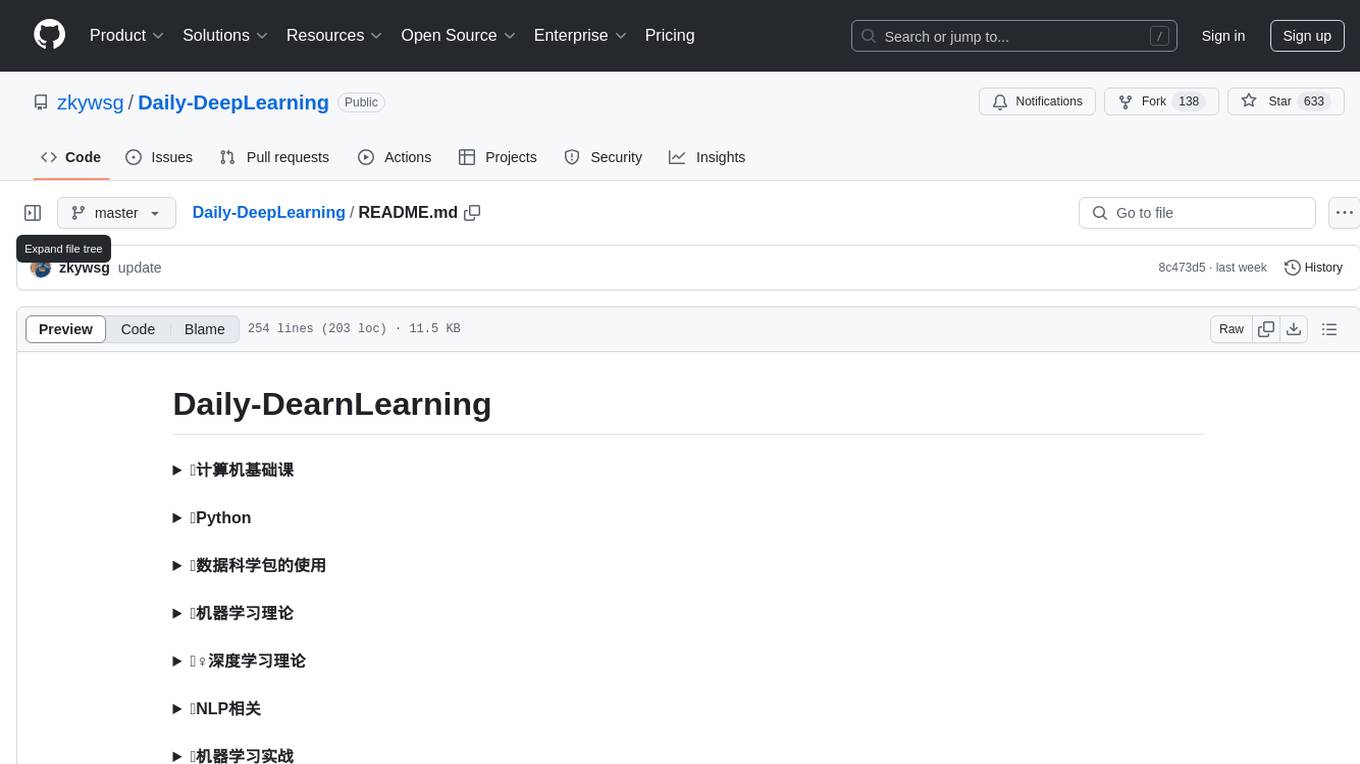
Daily-DeepLearning
Daily-DeepLearning is a repository that covers various computer science topics such as data structures, operating systems, computer networks, Python programming, data science packages like numpy, pandas, matplotlib, machine learning theories, deep learning theories, NLP concepts, machine learning practical applications, deep learning practical applications, and big data technologies like Hadoop and Hive. It also includes coding exercises related to '剑指offer'. The repository provides detailed explanations and examples for each topic, making it a comprehensive resource for learning and practicing different aspects of computer science and data-related fields.
For similar tasks

Awesome-LLM-Interpretability
Awesome-LLM-Interpretability is a curated list of materials related to LLM (Large Language Models) interpretability, covering tutorials, code libraries, surveys, videos, papers, and blogs. It includes resources on transformer mechanistic interpretability, visualization, interventions, probing, fine-tuning, feature representation, learning dynamics, knowledge editing, hallucination detection, and redundancy analysis. The repository aims to provide a comprehensive overview of tools, techniques, and methods for understanding and interpreting the inner workings of large language models.
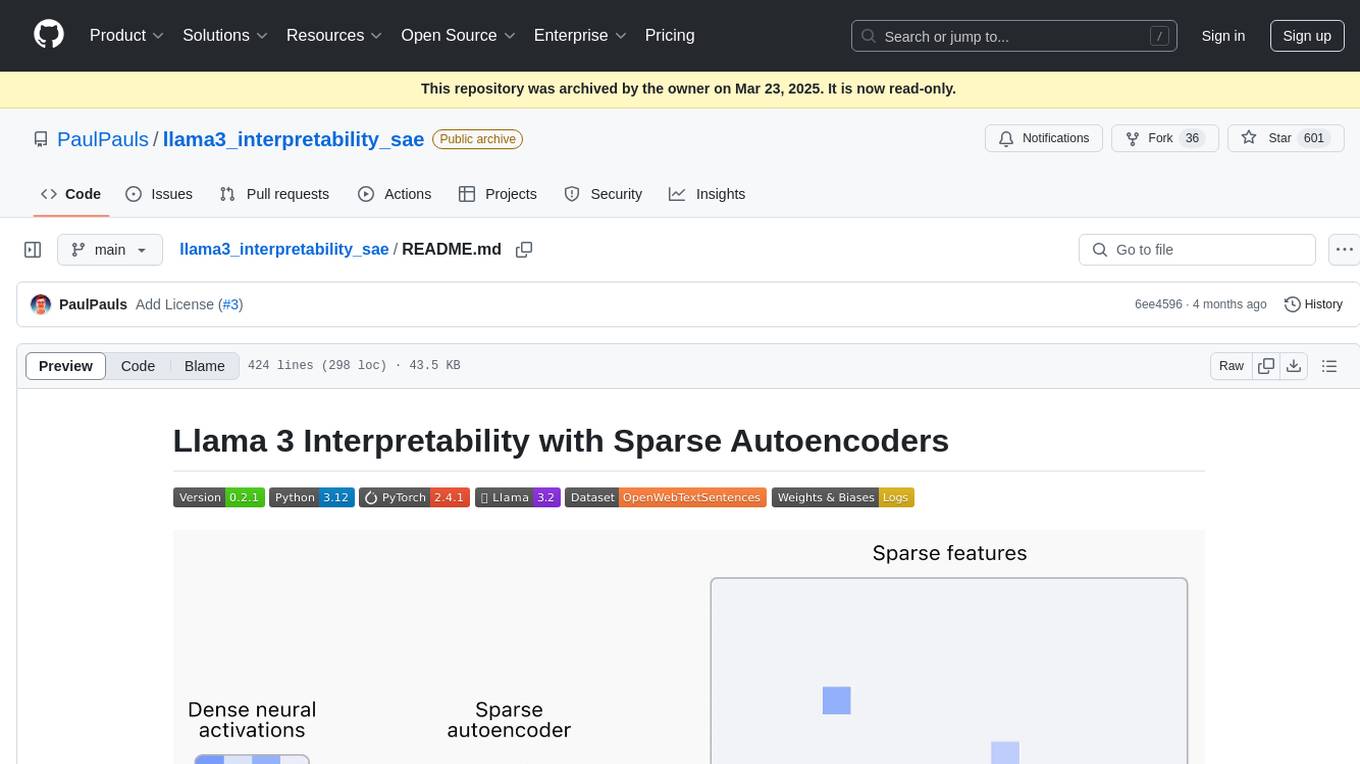
llama3_interpretability_sae
This project focuses on implementing Sparse Autoencoders (SAEs) for mechanistic interpretability in Large Language Models (LLMs) like Llama 3.2-3B. The SAEs aim to untangle superimposed representations in LLMs into separate, interpretable features for each neuron activation. The project provides an end-to-end pipeline for capturing training data, training the SAEs, analyzing learned features, and verifying results experimentally. It includes comprehensive logging, visualization, and checkpointing of SAE training, interpretability analysis tools, and a pure PyTorch implementation of Llama 3.1/3.2 chat and text completion. The project is designed for scalability, efficiency, and maintainability.
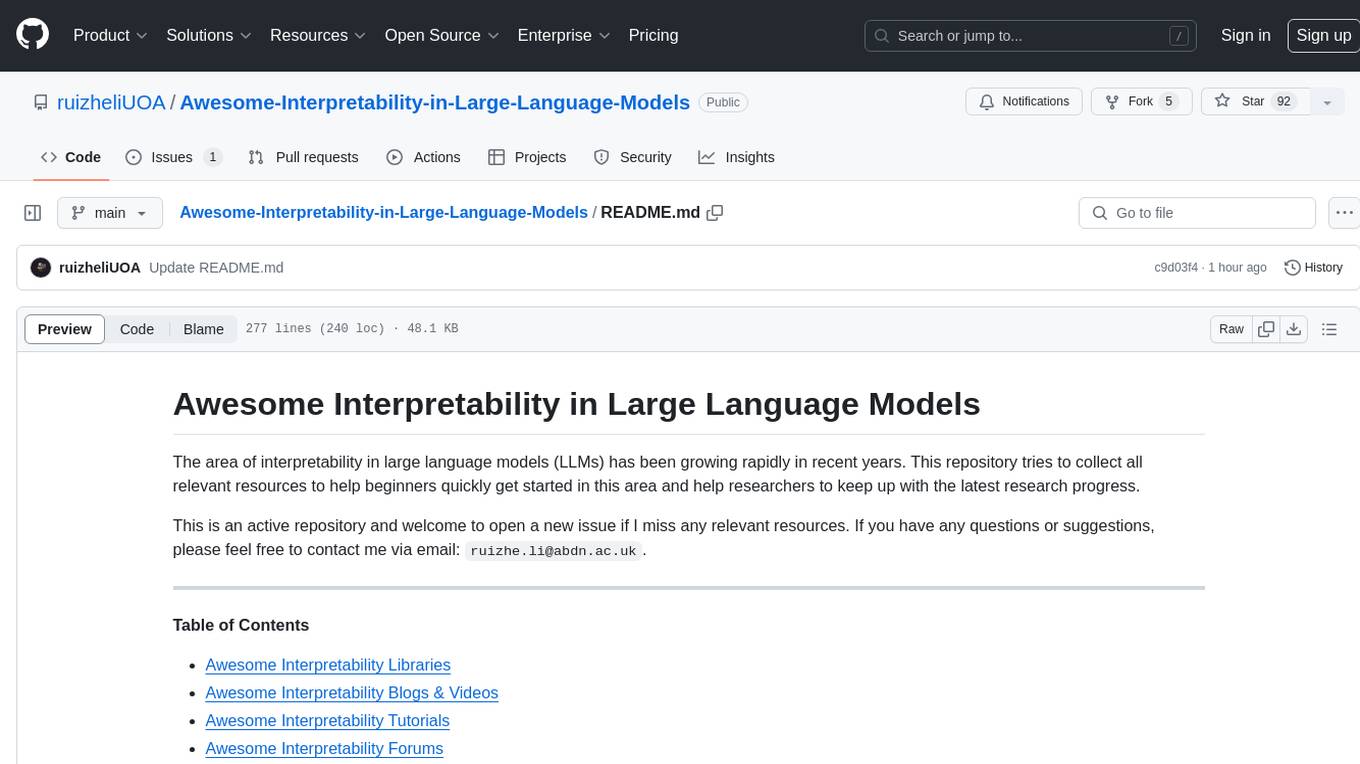
Awesome-Interpretability-in-Large-Language-Models
This repository is a collection of resources focused on interpretability in large language models (LLMs). It aims to help beginners get started in the area and keep researchers updated on the latest progress. It includes libraries, blogs, tutorials, forums, tools, programs, papers, and more related to interpretability in LLMs.
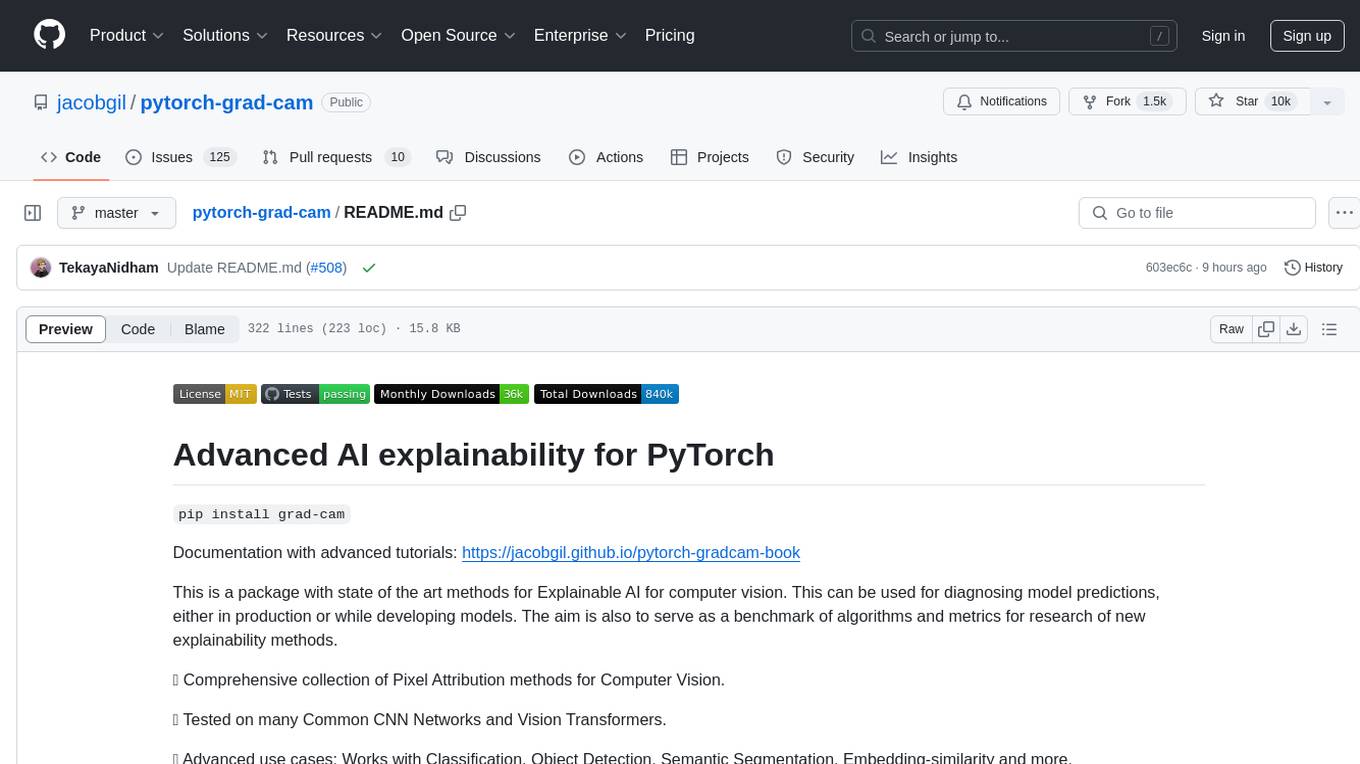
pytorch-grad-cam
This repository provides advanced AI explainability for PyTorch, offering state-of-the-art methods for Explainable AI in computer vision. It includes a comprehensive collection of Pixel Attribution methods for various tasks like Classification, Object Detection, Semantic Segmentation, and more. The package supports high performance with full batch image support and includes metrics for evaluating and tuning explanations. Users can visualize and interpret model predictions, making it suitable for both production and model development scenarios.
For similar jobs

weave
Weave is a toolkit for developing Generative AI applications, built by Weights & Biases. With Weave, you can log and debug language model inputs, outputs, and traces; build rigorous, apples-to-apples evaluations for language model use cases; and organize all the information generated across the LLM workflow, from experimentation to evaluations to production. Weave aims to bring rigor, best-practices, and composability to the inherently experimental process of developing Generative AI software, without introducing cognitive overhead.

LLMStack
LLMStack is a no-code platform for building generative AI agents, workflows, and chatbots. It allows users to connect their own data, internal tools, and GPT-powered models without any coding experience. LLMStack can be deployed to the cloud or on-premise and can be accessed via HTTP API or triggered from Slack or Discord.

VisionCraft
The VisionCraft API is a free API for using over 100 different AI models. From images to sound.

kaito
Kaito is an operator that automates the AI/ML inference model deployment in a Kubernetes cluster. It manages large model files using container images, avoids tuning deployment parameters to fit GPU hardware by providing preset configurations, auto-provisions GPU nodes based on model requirements, and hosts large model images in the public Microsoft Container Registry (MCR) if the license allows. Using Kaito, the workflow of onboarding large AI inference models in Kubernetes is largely simplified.

PyRIT
PyRIT is an open access automation framework designed to empower security professionals and ML engineers to red team foundation models and their applications. It automates AI Red Teaming tasks to allow operators to focus on more complicated and time-consuming tasks and can also identify security harms such as misuse (e.g., malware generation, jailbreaking), and privacy harms (e.g., identity theft). The goal is to allow researchers to have a baseline of how well their model and entire inference pipeline is doing against different harm categories and to be able to compare that baseline to future iterations of their model. This allows them to have empirical data on how well their model is doing today, and detect any degradation of performance based on future improvements.

tabby
Tabby is a self-hosted AI coding assistant, offering an open-source and on-premises alternative to GitHub Copilot. It boasts several key features: * Self-contained, with no need for a DBMS or cloud service. * OpenAPI interface, easy to integrate with existing infrastructure (e.g Cloud IDE). * Supports consumer-grade GPUs.

spear
SPEAR (Simulator for Photorealistic Embodied AI Research) is a powerful tool for training embodied agents. It features 300 unique virtual indoor environments with 2,566 unique rooms and 17,234 unique objects that can be manipulated individually. Each environment is designed by a professional artist and features detailed geometry, photorealistic materials, and a unique floor plan and object layout. SPEAR is implemented as Unreal Engine assets and provides an OpenAI Gym interface for interacting with the environments via Python.

Magick
Magick is a groundbreaking visual AIDE (Artificial Intelligence Development Environment) for no-code data pipelines and multimodal agents. Magick can connect to other services and comes with nodes and templates well-suited for intelligent agents, chatbots, complex reasoning systems and realistic characters.
